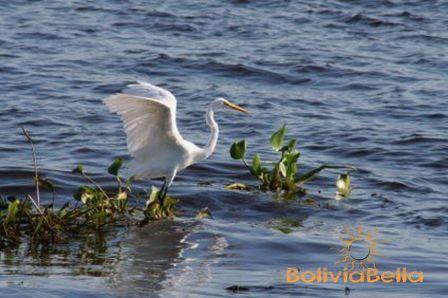|
Otuquis Nature Reserve in the Pantanal The Otuquis Pantanal, or wetlands was declared part of Bolivia’s National System of Protected Areas in 1997 and is part of the Bolivian Pantanal located in southeastern Bolivia bordering Paraguay and Brazil.
The reserve covers 1,005,950 hectares, of which 903,350 hectares are designated as a national park and 102,600 as a natural area of integrated management. Rainfall is estimated at 900-1,100 mm/year, with 80 percent of it falling between October and January. The mean annual temperature is 26oC. As a result of the interaction of the temperature, rainfall and height regimes, this zone is classified as "dry temperate forest” (bs-TE). Soils are composed of quaternary sediments of pluvial character. The internal hydrographic network does not posses a defined distribution pattern, being assimilated into a closed basin where water courses are born and die in the Paraguay and Negro rivers. One exception is the Otuquis River in the northern section which runs east and south and drains into the Pantanal, eventually ending up in the Paraguay River. Its flow rate varies between 1.55 m3/sec in September and 33.9 m3/sec in March. Three phitogeographic regions converge in Otuquis, Chaco, Cerrado and Amazonia, and flora and fauna characteristics of each can be found, as noted later on. The reserve is almost unpopulated; there are five or six farms. At its northern limit, however, there are ranches and urban populations of importance along the Santa Cruz-Puerto Suarez-Corumbá railway (constructed in 1940-45). In fact, 90 percent of the population in this region (25,426 inhabitants at last census) is concentrated along the railway line. As for cultural diversity the Otuquis is characterized by the presence of two indigenous communities, Chiquitanos and Ayoreos, who are Creole (Spanish: criollo) peasants and descendants of the Spanish colony; recent colonizers (Quechuas and Aimaras) from the Bolivian highlands; and foreigners, mainly from Brazil. The Ayoreo people (about 838 who live along the railway lines) have a semi-nomad culture, while the Chiquitanos people (about 2,819 in the same area) are a sedentary group partially because of the strong Jesuit influence from Spanish colonization. https://youtu.be/eaf8iFGVqvU Important economic activities take place around the reserve. Tourists number between 8,500 and 10,000 per year around the city of Puerto Suarez. In the Free Zone of Puerto Aguirre, commercial visitors number about 250,000 per year. Access is by plane, road and train, but in general the infrastructure is not well developed. Feasibility studies are being carried out to look for better solutions. Mining concerns in this area cover 301 hectares and operate mainly in the “Cerro Mutún” iron ore deposits, which are considered some of the world largest reserves (estimated at 25 million tons of secondary positive mineral reserves, 77 million of primary positive mineral reserves and 330 million tons of probable reserves), and which presently refine 15,000 tons/year of iron ore. The above information is part of a paper called “Wetlands in Bolivia”, written by Carlos B. Aguirre. Take a look at the official Pantanal website at www.pantanal.org for further information on the Otuquis Nature Reserve, the efforts being made to preserve the Pantanal wetlands, or the author.     |
